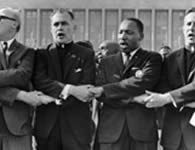
On a late spring day in 1964, Father Theodore Hesburgh, CSC, answered the phone with an invitation. Martin Luther King's crusade had moved north to Chicago, and a massive rally was being planned for June 21 at Soldier Field. Would Hesburgh, a member of the U.S. Commission on Civil Rights, show the flag for church and state? He agreed.
At the rally, Hesburgh gave an endorsement of the milestone Civil Rights Act, which banned segregation in the nation’s schools and public places, and was awaiting President Lyndon Johnson’s signature.
“Be proud to be a Negro,” he told a crowd estimated at 57,000. “We want to strive for dignity with you.” He linked arms with King to sing the movement’s anthem, “We Shall Overcome.”
A still-unknown photographer captured the moment, and, while Hesburgh received a copy of the photo shortly after the rally, it didn't take off in the campus imagination until much later. Hesburgh was presented with another copy of the photo following his talk at a King remembrance at Emory University in 1988. The snapshot was promptly given a position of honor in his library office, but it was not to be the end of the photo's journey. That came on October 9, 2007, in Washington, D.C., when an audience of Beltway and Notre Dame dignitaries gathered at the Smithsonian Museum of American Art and Portraiture. They were there to celebrate the long career of public service by Notre Dame’s president emeritus and to accept the Soldier Field photograph for the museum’s gallery honoring those who searched for justice in the 20th century.
For some in attendance, the Smithsonian event, emceed by NBC News correspondent Anne Thompson, a 1979 Notre Dame graduate, recalled a similar gathering in 1977 in Washington’s Mayflower Hotel, which recognized Hesburgh’s 25 years of human rights advocacy. On that occasion, the frail voice of civil rights pioneer Hubert Humphrey, dying of inoperable pelvic cancer, came over the telephone from his home in Waverly, Minnesota, to remind a hushed, black-tie audience of the long march to correct the republic’s birth defect.
Hesburgh’s service on the civil rights commission, the last three years as chair, highlighted the 16 presidential appointments he held between 1954 to 2001. His tenure on the commission from 1957 to 1972 was once again the centerpiece of a celebratory dinner. Harris Wofford, legal assistant to the commission, recalled that Hesburgh, an independent among three Southern Democrats and two Northern Republicans appointed by President Dwight Eisenhower, did some bourbon bridge-building at a 1959 meeting.
“His fellow commissioners weren’t much for drinking,” Wofford told dinner guests, “so when segregationist and former Virginia governor John Battle wanted a companion for a nightcap, he turned to Father Hesburgh.” Hesburgh gave a cause characterized as radical by its opponents firm roots in Judeo-Christian ethics, and the commission surprised Eisenhower with recommendations sounding the first death knell for Jim Crow.
As civil rights leader Andrew Young put it in a taped tribute, “If Father Hesburgh was for you, you didn’t care who was against you.”
The major issues Hesburgh dealt with in his public service career had moral overtones—civil and human rights, immigration and refugees, nuclear proliferation, global hunger and poverty, to name a few. As former Wyoming senator Alan Simpson, who served with Hesburgh on the 1980 Select Commission on Immigration and Refugee Policy, observed, Hesburgh got assignments tinged with “guilt, fear, emotion and racism” but always found ways “to bring reason to the fore.”
In a dinner video précis of Hesburgh’s contributions to the commonweal, narrated by retired CBS Evening News anchor Walter Cronkite, Father Ted was described as a “servant of hope.” In the video, three former presidents—George H.W. Bush, Jimmy Carter and Bill Clinton—praised his work on behalf of peace and justice. Before the dinner, Hesburgh spent a half hour with President George Bush in the Oval Office.
In his dinner response, Hesburgh showed his deep-keeled optimism. He deflected praise to those who had supported him over the years. “Life is more than despair or darkness if we work together for higher goals,” he said. “I am filled with gratitude for having lived part of my life with each one of you here.”
The reception preceding the dinner was attended by two of the most powerful women in Washington, albeit from different political factions—Secretary of State Condoleezza Rice ‘75M.A. and Speaker of the House Nancy Pelosi. Rice concluded her remarks by referring to a letter she’d recently received from Hesburgh. “He reminded me,” she said, “that the most important thing that I could do whenever times were challenging was to say, ‘Come, Holy Spirit.’ And, he said, ‘The Spirit will be upon you.’” After her talk, in a poignant, almost imperceptible gesture, Hesburgh signed her forehead with a blessing.
The day of the dinner, in Freedom Plaza outside the hotel where Hesburgh and the Notre Dame party were staying, about 200 immigrant Ethiopian taxi drivers protested the District of Columbia’s proposed fare regulations. It was not exactly Soldier Field in 1964, but it was part of the same long march.
Dick Conklin retired in 2001 as associate vice president of University Relations at Notre Dame.